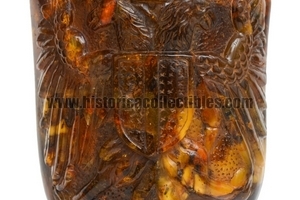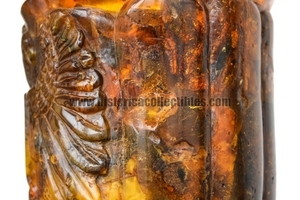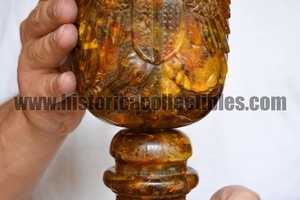Cup of Honor in natural Baltic Amber, Holy Roman Empire, 1590-1650
Cup of Honor in natural Baltic Amber, made between approximately 1590 and 1650, belonging to a high member of a noble family reigning over a fiefdom forming part of the Confederation of Central and Western European States better known as the Holy Roman Empire (probably noble member of the Habsburg family).
The large Cup is expertly enriched by a large, finely carved and engraved crowned double-headed eagle, bearing on the chest the coat of arms or "party" of the House for which it was made. This is divided by a vertical band: a prancing horse, surrounded by small "moscature", is shown on the left band while on the right side of the coat of arms the "moscature" develop over the entire surface. Typical of the late Renaissance taste are the pods sculpted on part of the circumference of the large cup, while its "spool" support base already shows characteristics of the Baroque taste.
Ancient artifact, probably made by the workers of the city of Königsberg, produced entirely in authentic and natural Baltic Amber.
Amber (in ancient Greek ἤλεκτρον, elektron) is a term used in the past as a synonym for fossil resin and resinite and this ambiguity has been a source of misunderstandings and confusion. In particular, in ancient European literature, the term amber was used in a very restrictive sense to identify "succinite", the most important variety of Baltic amber from a gemological point of view, and even today this meaning is very common, probably due to the The commercial importance that this variety of amber has had in European history.
In the scientific community today, amber means any fossil resin, and its varieties are identified according to geographical origin.
Amber is emitted by conifers in the form of resin, which subsequently fossilizes over time and in some cases solidifies, preserving plant, fungal or animal remains including arthropods but also, much more rarely, vertebrates. It is translucent, of a color that can vary from yellow to reddish to brown up to green. It may contain insects that were trapped at the time of its formation. It is currently commonly harvested in Poland, Lithuania, Latvia, Russia, Denmark, Germany and Sweden. Its processing is widespread in the countries bordering the Baltic Sea such as: Poland, Lithuania, Latvia, Germany and Sweden. Amber is used in the production of stick handles, necklaces, earrings, bracelets, rings, cigarette holders and pipe stems.
Fossil amber has also been found in sediments from the Carboniferous age, a geological period before the appearance of angiosperms. This amber has chemical characteristics similar to more recent ambers, indicating that the biological mechanisms capable of producing these resins were already present before the evolution of angiosperms.
The etymology of the term is uncertain, having no explanation in Arabic, from which it seems to derive due to the prefix.
This resin was also collected in ancient Egypt where precious objects were produced with it.
Amber jewelry has also been found in Greece, where it was called elektron. According to the myth, when Phaeton son of Helios (the Sun) was killed, his mourning sisters became poplars and their tears became the origin of elektron, amber.
Although amber was known in Greece, there are no known amber deposits, it probably arrived commercially from trade with northern Europe along the amber route, which had a deviation towards the Danube valley, a natural route followed for the amber trade amber, from which it was then traded towards Illyria and the Aegean.
Among other things, amber was also found in southern Italy and Sicily and was worked by the Italic peoples. These finds of exceptional historical and artistic value are preserved in various museums such as the National Archaeological Museum of Siritide in Matera.
Amber was also well known in India where it was imported from Burma.
Baltic Amber has an average age between 10 and 40 million years. The Amber Route, once also known as the "Imperial Route", is a route of approximately 418 km that crosses the Baltic countries and Russia, traditional producers of fossil amber. Baltic amber is characterized by containing a large quantity of succinic acid, from which the mineralogical name of "succinite" derives.
Succinite does not only mean the amber found on the coasts of the Baltic Sea in northern Europe. Although the major deposits are found in that area, the amber, over time, has been eroded by marine sediments, carried inland by storms and carried by streams and glaciers to secondary deposits found in the most of eastern and northern Europe, dating back to the late Eocene.
Baltic amber deposits are the largest and most extensive in the world and also the most studied since the 19th century. Baltic amber appears to be 90% from a single botanical source, but which one it is is not yet clear, given that the evidence from paleobotanical studies and that from chemical studies are discordant.
In the past the source suggested by Goeppert (1836) was the resin of Pinites succinifer, from the analysis of wood found associated with the resin. The suffix -ites was used by the author to suggest affinity, but not identity, with living species of Pinus, but other authors used the term Pinus succinifera, generating confusion and the (incorrect) idea that amber had relationships of chemical type with the resin of living Pinus. More recently, hypotheses have focused on two possible origins:
- from a species of the Araucariaceae, closely related to the species of the modern genus Agathis, typical of the flora of South East Asia.
- from a species of the Pinales, closely related to the species of the modern genus Pseudolarix. This genus currently includes only one species widespread in a small area of Eastern China. However, it is the only living conifer with a percentage of succinic acid similar to that found in Baltic amber.
Amber has been used since the Stone Age, over 22,000 years ago. Amber ornaments have been found in Mycenaean tombs and virtually everywhere in Europe. Tradition attributes it with medicinal powers, perhaps linked to its well-known electrostatic properties (if rubbed with a cloth it becomes electrified). According to a Turkish fable, amber mouthpieces prevent infections when exchanging pipes (hookah). It is still used today in the industrial production of mouthpieces for pipes and glass blowers. There is even an Amber museum in Palanga, not to mention the famous Amber Room contained in Catherine's palace, in Tsarskoye Selo in Russia, near St. Petersburg.
There are numerous varieties of amber, and also numerous imitations. The colour, inclusions and transparency of amber can vary not only based on the composition of the original resins from which it fossilized, the substances present in the soil from which it was collected but also the treatments to which it was subjected to create objects. and jewelry.
The most widespread amber in jewelry today is that from the Baltic countries. The International Amber Association has established the following classification:
- Natural Baltic Amber - gem that has been subjected solely to mechanical treatment (for example: grinding, cutting or polishing) without any modification of its natural properties.
- Modified Baltic Amber - gem subject only to heat or high pressure treatment, which has changed its physical properties, including the degree of transparency and color, or shaped under similar conditions out of a nugget, previously cut to the required size.
- Reconstructed (pressed) Baltic Amber - gem made of pieces of amber pressed at high temperature and under high pressure, without additional components.
- Glued Baltic Amber - gem consisting of two or more parts of Natural, Modified or Reconstructed Amber, glued together using the smallest possible quantity of colorless adhesive agents.
Naturally these four categories of amber have a very different value and market price.
To these four categories are then added a variety of pseudo-ambers or counterfeit ambers. Amber (particularly that with insects included) is frequently counterfeited using common plastic or resin. A simple test (but to be carried out with particular precautions so as not to ruin the object) consists of touching the object itself with a hot pin and determining whether the odor released is that of wood resin. If not, the item is definitely a counterfeit, although a positive test may not be sufficient due to a thin layer of real resin on top of the plastic. Generally counterfeits have poses and positions of the trapped insects too perfect to be realistic.
References:
Amber Museum in Kaliningrad
Museo degli Argenti (Palazzo Pitti Firenze)Codice Catalogo Nazionale: 0900749922
Museo statale dell'Ermitage, San Pietroburgo (Koenigsberg. XVII secolo) Inv. N. E-6282
The Amber collection in the Dresden Green Vault (Vessel in the form of a Nautilus sell, H, Jakob, Königsberg, dated 1659): IV 340
The Amber collection in the Dresden Green Vault (Pokal with Humpback rows, Konigsberg 1570-1580): IV 329
The Amber collection in the Dresden Green Vault (Humpback Cup with Venus): III 92
Czartoryski Museum, Cracow, Poland (Amber cup, amber, silver gilt and pearl, by Polish School, 16th century: CZA247338
Castello Pandone: Codice Catalogo Nazionale: 1400054475
Literature:
Camille COPPINGER, Ambre, mémoire du temps, Edition Thalia, Italie





